Marketing departments are often chaotic places where keeping organized, communicating clearly, and hitting deadlines feel like pipe dreams. Last-minute projects derail priorities, meetings that should have been emails take you off task, and late nights at the office are part and parcel with the job.
It all adds up to project delays and wasted money for substandard work. Those three things together do not add up to a productive workplace or a satisfying career.
Marketers aren’t the first folks on the planet to face these issues though. Nor were they the first to devise a better way of managing projects and shipping work on time. In fact, one of the best solutions to these problems (and more) has its roots in software development (and before that, auto manufacturing).
It’s called scrum, and this chapter is all about how it works.
Download: Sprint Backlog Template
In this Excel template will help you implement scrum with your marketing team by planning projects in advance. Each field has a clear explanation of what goes where (plus more detail will be provided later in this guide). Download your copy below:
What is the Scrum Framework?
If you’re unfamiliar with the context, then hearing the word “scrum” might make you think of something like this:

The kind of scrum this guide is talking about though looks more like this:

The less-athletic of those amongst us can breathe a sigh of relief.
Getting down to business, scrum is an agile framework for managing projects from start to finish. It’s based around the values of self-organizing teams iterating rapidly on collaborative plans. By removing as much waste and red tape from workflows as possible, everyone’s effort can be focused on doing the most important task at each step of a project.
This video from the Scrum Company explains how it works (for all different applications):
Here is a visual breakdown of how scrum works as well:
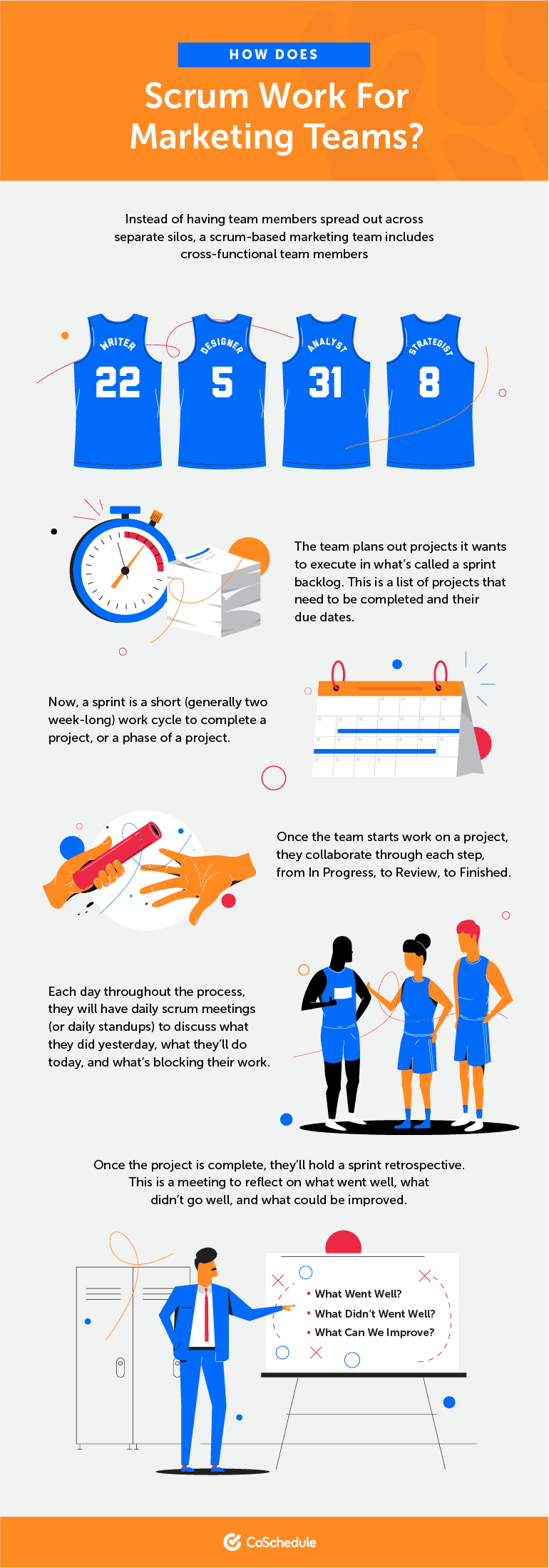
Who Came Up With All This Stuff, Anyway?
There’s a little bit of debate around who exactly devised the scrum framework and who coined the term “scrum” itself.
It’s commonly accepted that it first appeared in the Harvard Business Review in a 1986 article titled “The New New Product Development Game” by Ikujiro Nonaka and Hirotaka Takeuchi. It was later documented in deeper detail by Jeff McKenna, Jeff Sutherland, and John Scumniotales.
However, according to Techwell, “Jeff Sutherland invented scrum and later introduced it to Ken Schwaber.”
Regardless of which side you’re on, everyone can agree that several smart people devised and refined the framework to develop a better way of getting products built and shipped. For marketers, rather than thinking about products or software, we instead focus on projects and campaigns.
Scrumban: One Variation on Scrum
Scrum doesn’t necessarily need to be executed just one way, either. There are several different variations to choose from, and it’s adaptable to the needs of the organization putting it into place.
One such variation is called scrumban, which is a combination of scrum and kanban. In this process, scrum is combined with a kanban board that helps teams to visualize project progress:

The process described in this guide is closer to scrumban than a pure scrum framework. This is not to suggest that one approach is better than another, but it is one that can work well for marketing teams.
In addition, CoSchedule supports Kanban-based workflows with Kanban Project Dashboard (available on Professional and Enterprise Work Organizer and Marketing Suite plans—see details). This makes it easy for teams to manage projects and visualize workflows from start to finish:
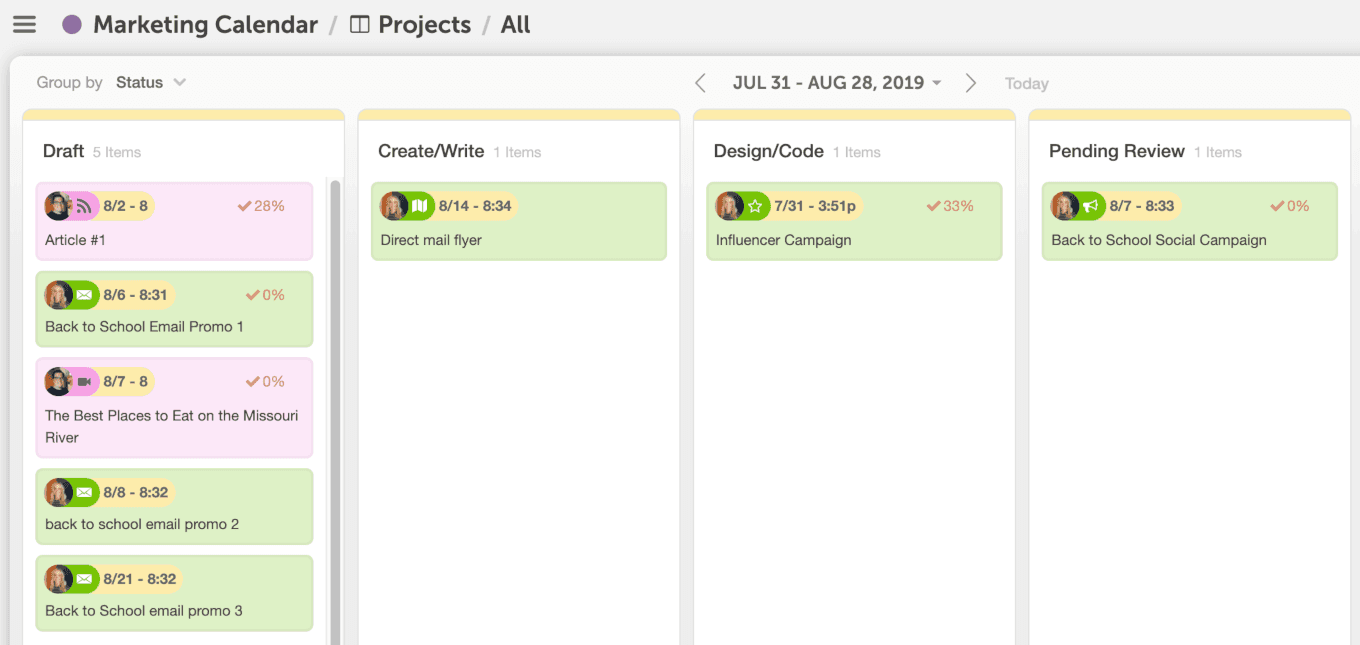
Grab the Official and Freely Available Scrum Handbook
For a more in-depth exploration of scrum and its application, it’s worth downloading the official guide.
You can read the entire thing online or download a PDF (in over 30 languages, no less). There may be more information there than you strictly need, but it remains worthwhile reading.
The Scrum Terms and Definitions You’ll Need to Know
This guide has already thrown a few terms around you might not have known before. So, before moving much deeper into the world of agile, it’d be helpful to explain some basic terminology you’ll be likely to encounter. It can seem complicated at first, but the general concepts behind agile are simple enough to easily understand the basics.
Here are some basic definitions (worded to make the most sense in a marketing context):
- Product Owner: The primary decision-maker on a scrum team.
- Scrum Master: Leads meetings and standups, removes roadblocks, and oversees the scrum team.
- User Story: A brief explanation of the who, what, and why behind a project.
- Tasks: An item that needs to be completed by a scrum team member.
- Backlog: A repository of project ideas that may be executed in the future.
- Sprint: A short period of time during which a project will be completed (generally a week to a month).
- Standup: A daily morning meeting where the team shares what they did yesterday, what they’ll do today, and anything that’s preventing them from moving forward.
- Retrospectives: A meeting to reflect on how a sprint went, what was learned, and what could be improved upon in the future.
- Blockers: Anything that’s preventing a team member from completing their work.
- Minimum Viable Product (MVP): A bare-level project intended to show proof of concept.
- Kanban: A visual framework for tracking steps in a process that uses columns and status indicators moving from left (beginning) to right (completion).

How Are Scrum Teams Organized?
Scrum is all about getting teams to work well together so they can get projects done efficiently and on time. In order to achieve this goal, they need to be structured in a way that facilitates proper implementation. They should start by including three different roles:
- The Product Owner establishes what’s needed for completion. As stated before, this is the central decision-maker on the team. For marketing teams, the term “Project Owner” may make more sense.
- The scrum master manages the process day-to-day. This entails removing blockers, running standups (daily status meetings covered in chapter 5) and retrospectives (post-project meetings covered in chapter 7), and ensuring the team has what it needs to get its work done. This can be the same person as your Project Owner, or another individual.
- Each team member takes care of their own work. Rather than having a boss breathe down their neck, standups and ongoing communication between team members keep everyone in the loop on project status. Transparency ensures everyone knows how work is progressing and can anticipate next steps.

How Does Scrum Work for Agile Marketing Teams?
Now that you understand the general philosophy behind scrum and the verbiage involved, it’s time to take a look at how it functions in the real world.
This section will walk through the entire process on a hypothetical marketing project from start to finish. Note that this may not be the exact process every agile marketing team, but this example is based on the actual steps used by the CoSchedule marketing team.
Creating a Project Backlog: Every Project Starts With an Idea
Creative marketing departments are often full of ideas. Tons of ideas. More ideas than they know what to do with.
For marketers at CoSchedule, quarterly project planning begins with a brainstorming meeting (note: this process works with any type of marketing team or projects).
At a high level, this entails talking through ideas (many of which have probably been discussed before in some form) and prioritizing which ones are the most likely to deliver the desired results.
These ideas are stored in a campaign ideas spreadsheet. Traditionally in scrum, this would be called a “product backlog.” For marketing purposes, however, it may make more sense to call it a “project backlog.”
It looks something like this (and you can find a copy of this template in the downloadable ZIP folder included in this chapter):

Here’s what’s included in this document:
- Tactic: It may be more appropriate to label this “campaign” or “project,” but this column is reserved for whatever it is you’ll actually do.
- Owner: Who on the marketing team is driving this?
- Goal: What outcome will this influence?
- Problem: What top problem will this tactic, project, or campaign solve that’s currently preventing your marketing team from attracting more customers?
- Story: “As a marketer, I want to [IDEA] so that we solve [TOP PROBLEM]” (complete this sentence to explain the project).
- Hypothesis: “[IDEA] will improve [GOAL] by [PERCENTAGE].”
- Measurement: Briefly explain how the campaign, tactic, or project will be measured to prove its impact.
Later, when a project has actually been shipped, the following can be completed:
- Date Shipped: The publish or launch date for the project.
- Date Analyzed: When were the results of the project measured and analyzed?
- Actual Result: What does the data show?
- Retro Date: When did the team hold a sprint retrospective on this project?
- Next Steps: What will the team do in the future as a result of executing this project?
Once again, it’s okay if this doesn’t all quite make sense yet. During the initial planning phases, the details for several different ideas will be documented in this spreadsheet. Think of this like a rough scratchpad for outlining the “why” behind the “what” for everything the team will execute.
CoSchedule customers can also use the Idea Board to manage their project backlog. It makes it possible to organize ideas into columns (which you can label what you would like). This works best for unplanned projects:

Planning Sprints and Building Up a Sprint Backlog
Once projects have been identified, prioritized, and selected, it’s time to plan them out into sprints.
The nuts and bolts of sprint planning will be explained in a later chapter, but at a high level, sprint planning entails determining all the tasks that each team member will be responsible for on each project. It also charts out when each step will be due.
A sprint backlog can be planned out in a number of different ways, including using physical Post-It notes on a wall or whiteboard. They can also be planned out in a spreadsheet or using a project management tool (CoSchedule incorporates the features necessary to do this work).
All a successful sprint backlog needs are the following items:
- Estimates on how long each step will take. This can be challenging, so it’s often best to overestimate time to build in a buffer against missing deadlines.
- Placing each step into the correct order. Know which steps need to be completed, and who needs to complete them, to keep the project moving.
- Ensuring the entire team has full visibility on upcoming sprints. Whatever method of building and planning sprints you use, make sure your tool or method can be easily accessed by the entire team.
The nuts and bolts of sprint planning and execution will be covered in a later chapter. For now, this is enough to give you a theoretical idea of how they work.
Daily Standups and Proactive Communication
A standup is a daily morning meeting where the team meets to discuss project progress. Each team member shares the following information:
- What did they do yesterday? Which concrete actions did they execute?
- What will they do today? And does their work accurately follow the sprint?
- Is there anything stopping them from getting their work done? And how can those blockers be removed?
These meetings should take 15 minutes or less. By setting time aside to sync on work, teams can ensure a consistent flow of information so no one says, “Oh, I didn’t know that was happening,” or “Sorry, I didn’t know I was supposed to have this done yet.”
You may have one broadly-focused standup in the morning to discuss all your work, separate standups for each project, or a combination of the two approaches.
CoSchedule helps support teams manage standups with its Team Management Dashboard (available on Professional and Enterprise Work Organizer and Marketing Suite plans—see details). It clearly shows all the projects and tasks each member of a marketing team is working on day-to-day, providing total transparency and clarity on who is doing what.
It displays days and tasks in horizontal view:
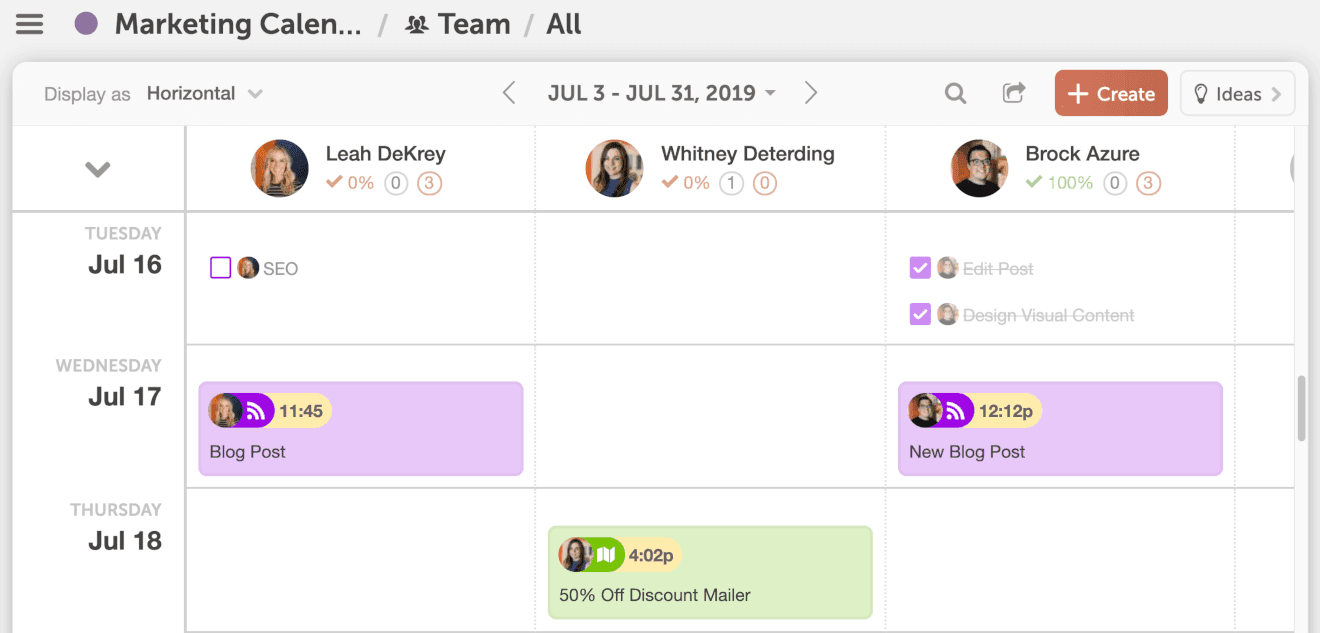
And in a vertical alignment too. It’s highly customizable as well so teams can adjust the way it works to their own needs:
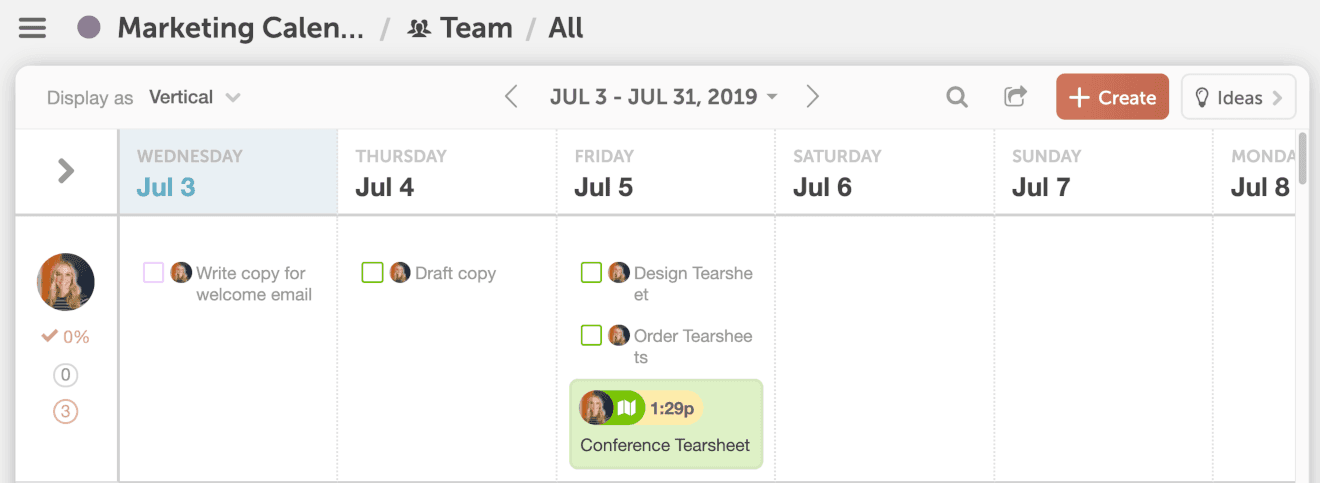
The Kanban Project Dashboard (available on Professional and Enterprise Work Organizer and Marketing Suite plans—see details) offers another view for managing planned projects. Once all the tasks are completed for a particular project phase, it can be moved over one column to the right:

The Marketing Calendar (available with all CoSchedule plans—see details) in CoSchedule offers yet another way to visualize upcoming work. All views can be filtered to include only the team members and work that individual teams may care about most:
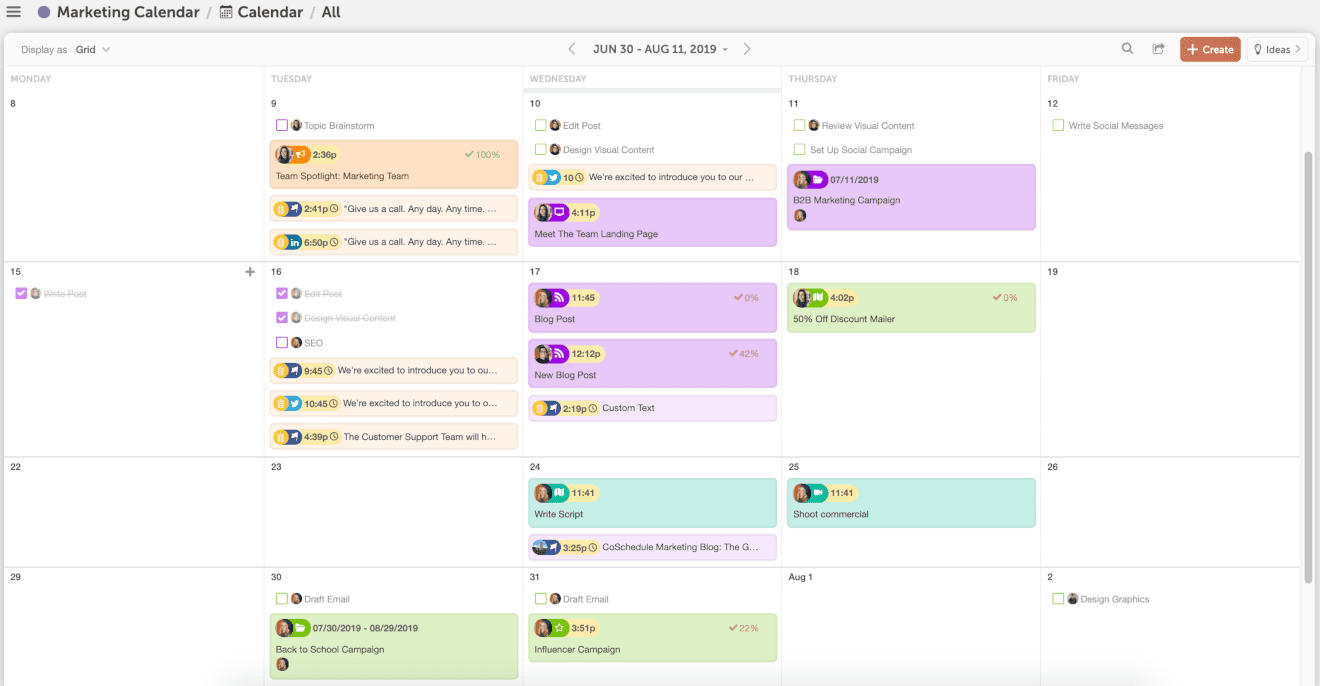
Removing Blockers
If a team member has a blocker, it’s important to remove that obstacle as quickly as possible. This will help keep the team moving along and prevent the project from going over deadline due to an unforeseen hurdle.
Here are some common blockers you might encounter:
- An app or tool is down. The team member can’t work because their tools aren’t working.
- Team member doesn’t have access to a file or service.
- Another team or team member hasn’t completed their steps yet. In this case, you’ll need to determine what the issue is and determine how the work will get done on time.
Ultimately, a blocker can be anything that’s preventing the team member from making progress.
Sprint Retrospectives
Once the sprint is complete and the project has been shipped, it’s time to look back on how the project performed, and identify lessons learned and areas for improvement.
Like with daily standups, you may choose to run a retrospective for all work at the end of the week, and project-specific retros for each project you execute. This approach ensures you’re evaluating each project and campaign, as well as evaluating how things are going with your team as a whole.
It’s best to gather the entire team into a room for this meeting. One team member should pull up a document on a computer (ideally on a television or sharing their screen so everyone can see) and note the following:
- Was the project successful? In other words, did the sprint meet its goals?
- What went well? Celebrate some wins!
- How could it be improved for next time? Inevitably, there are bound to some things that didn’t go so well too. Think on how you can do better next time around.
That summarizes the bulk of how scrum can be applied to a marketing context.
That’s a Wrap
Hopefully, this chapter has provided you with a useful understanding of the agile framework. Plus, you’ve gotten a quick look at how CoSchedule can help support scrum with marketing teams.
